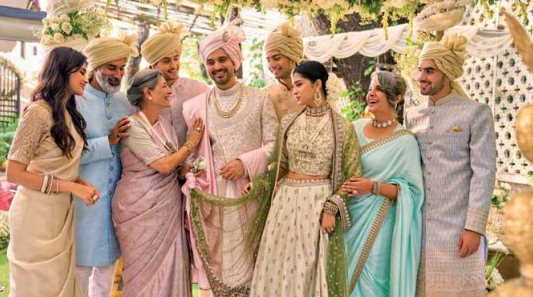Occasion/ceremonial menswear brand Ethnix by Raymond started its journey in the year 2017 with a launch in the trade channels. The brand was an instant hit and merely two years into its launch, in 2019, Raymond decided to create a unique identity for Ethnix. One EBO was launched in 2019 and after observing its initial success, Raymond decided to expand the brand’s network. The expansion came to a halt in 2020, during the pandemic, but the demand did not stop and in 2021, the brand continued on its expansion journey, unabated.
Bidyut Bhanjdeo, Chief Business Officer, Ethnix by Raymond says that the organised ethnic menswear market – which is growing at 10-12% – is being driven on the back of select trends including:
- Growing trend of wearing Indian ethic wear on occasions and milestone celebrations. This trend is further buoyed by movies and TV soap operas showing larger than life marriages and occasions being celebrated wearing Indian ethnic clothes.
- Entry of organised branded players into the segment driving a shift from unorganised to organised players.
- Increase in reach and penetration of branded stores in not only Tier 1 cities and metros, but also Tier 2 & beyond.
- Evolution of fusion wear, which is combination of the western and Indian ethnic wear segments.
He adds that consumer preference, which was directed towards western wear a few years ago, has shifted to Indian ethnic clothes, especially on occasions like weddings, festivals etc. “There is a growing preference towards pastel shades and tonal designs in different fabrics. Consumers are experimenting with silks and linens in this segment,” says Bhanjdeo.
 He explains that emerging categories include short, casual kurtas, fashionable bottomwear and asymmetric silhouettes. “There is also an increase in demand for more intricate work on the garments.”
He explains that emerging categories include short, casual kurtas, fashionable bottomwear and asymmetric silhouettes. “There is also an increase in demand for more intricate work on the garments.”
Aside from this, Gen Z today is also experimenting a lot with fashion and Ethnix by Raymond has created a casual range called ‘Smart Ethnix’ which includes designs like short kurtas, linen trousers and parallel trousers using a lot of Indian fabrics. “Not only is this very high on fashion which is relevant for the young but the use of a variety of Indian fabrics keeps clothes rooted in tradition,” he says, adding, “Our designs are all developed in-house, and our design teams look for inspirations from Indian art forms like temples and fort carvings. We are also working on reviving traditional, dying forms like Bagru prints with our designs and concepts.”
Omnichannel Capabilities
Bhanjdeo says that while basic ethnicwear like plain kurtas have some contribution on online channels, most categories are purchased in-store since ethnicwear is a high involvement category.
“People buy into an entire look which consists of garments as well as matching accessories. This is possible only when a consumer comes to a store and tries and buys a complete look. Customisation is also easier when the purchase in made in store.”
Despite this, he stresses on the importance of Omnichannel capabilities for a brand, saying, “Our stores are connected for inter-store transfer of inventory as per consumer requirement. Our store inventory is also listed on e-commerce marketplaces, which drives online sales.” Ethnix, he says, is working on building a robust Omnichannel strategy to increase the contribution of revenue from online channels.
Innovation in Collections
Bidyut Bhanjdeo, Chief Business Officer, Ethnix by Raymond, says that his brand is driving two sections:
- Casual Ethnicwear: We are promoting products under the ‘Smart Ethnix’ brand, which constitute short and mid-length kurtas. This is an alternative to western casuals and is an innovation in ethnicwear. This collection will be relevant to throughout the year, not just in the festive season. Fabrics like silk, linen and jacquard, with ethnic prints and traditional dyeing and printing techniques are being used to create this collection.
- Festive & Ceremonial Line: Ethnix is using intricate, tonal, hand embroidered design motifs in pastel as well as darker shades. Newer silhouettes are being used in fusion wear and Indo-western wear. We have also introduced ceremonial suits that have intricate work for bridegrooms.
Challenges in the Ethnicwear Category
The ethnicwear segment in the Indian apparel market is divided into men, women and kids wear, with the market split being 85% for women, 12% for men and 3% for kids. “The three sub sections are growing at similar rates and are buoyed by more brands jumping into the fray, more market penetration and reach of online players,” explains Bhanjdeo.
However, while the segment is growing at a fast rate, Bhanjdeo acknowledges the fact that the unorganised sector poses a huge challenge to the category. “Unorganised players offer cheaper products, competitive pricing as well as hyper-customisation – down to the last stitch. While organised players do offer customisation, the focus is not as minute. Organised mass market brands are however working hard to surmount this challenge,” he explains.
Bhanjdeo says one way of countering this challenge is working on more innovations in designs and silhouettes, which will drive better sales. “Also, better reach of exclusive brand outlets will also help in improving sales,” he adds.
Another effective way is bringing in more technology. “Since organised players generally have more money to play with, bringing in sophisticated technology for buying and post purchase ease will definitely boost the sector.” His favourite technology is buying and merchandising automation which helps in relevant merchandise being placed in stores.
Expansion Plans
Ethnix, which sources fabric from weaver clusters providing them with a sustainable income, is also working on incorporating sustainable fabrics, all the while planning an aggressive expansion in 2024.
The brand is planning on opening 300+ stores in the next 2 years. Out of this, 50+ stores will be launched in 2024 itself.
While the brand acknowledges the strong diaspora consumer base for men’s ethnicwear and high potential market segments abroad, international expansion is still on the drawing board. The brand though is on track as far as domestic expansion goes and is planning to ensure its presence in all Tier 1 cities and a good proportion of Tier 2 & beyond including in cities like Aligarh, Asansol, Akola, Bhagalpur and Bilaspur to name just a few.
“We will be selectively expanding into new geographies in Tier 3 & 4 towns as well,” says Bhanjdeo.
The brand is present on the Myntra marketplace, which is linked with Ethnix’s offline stores. It is also focused on expanding its online business this year through its own site www.myraymond.com.



